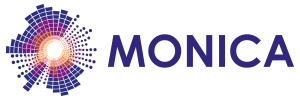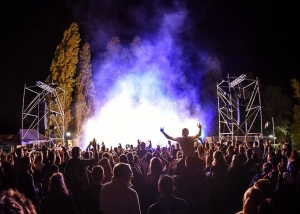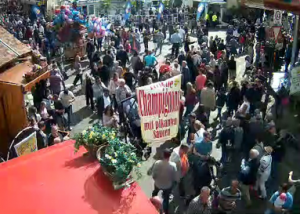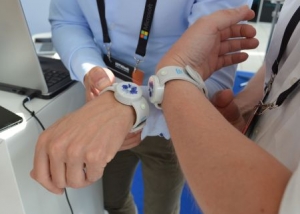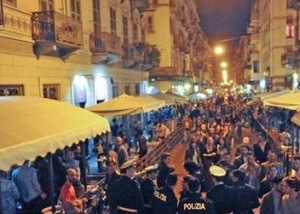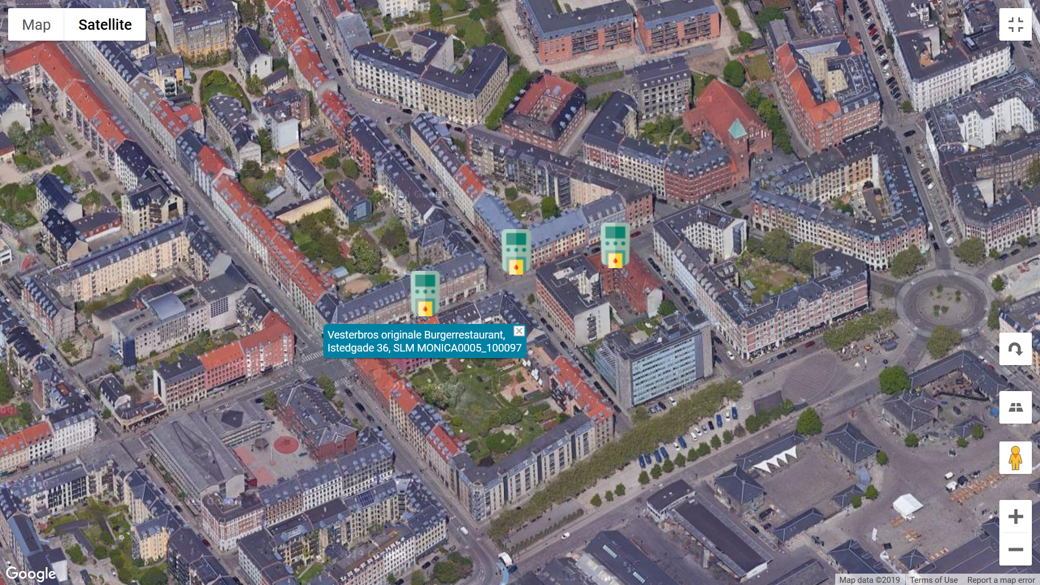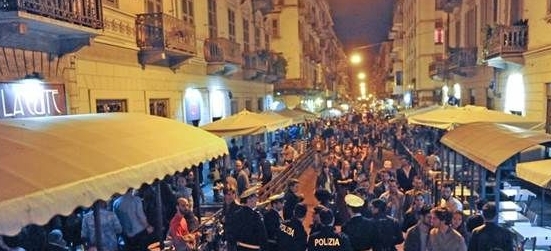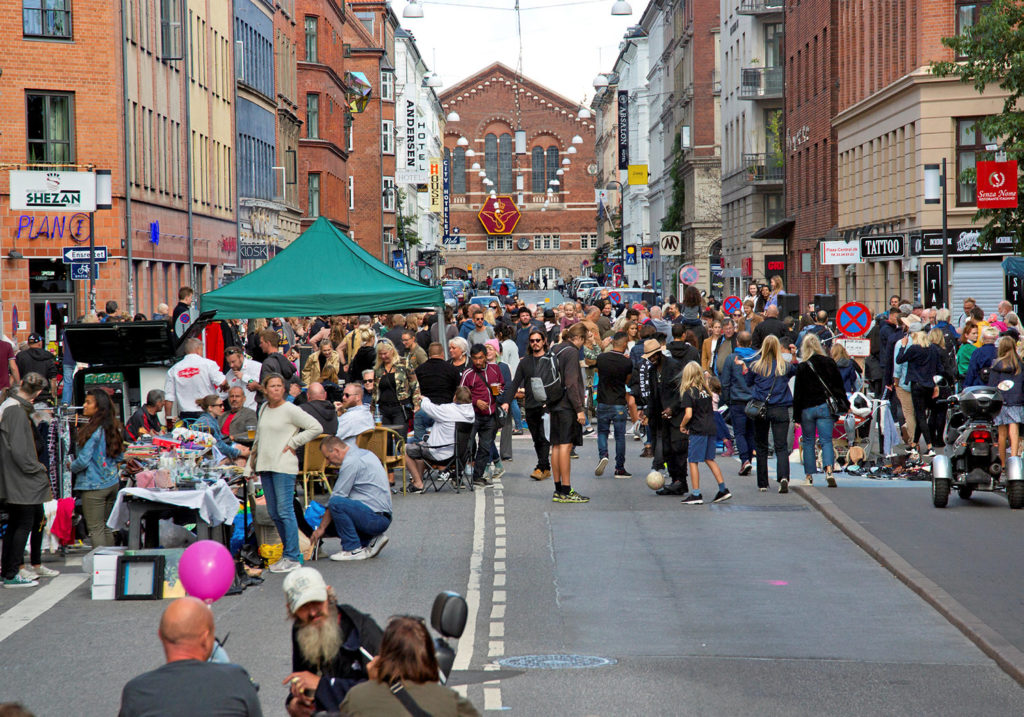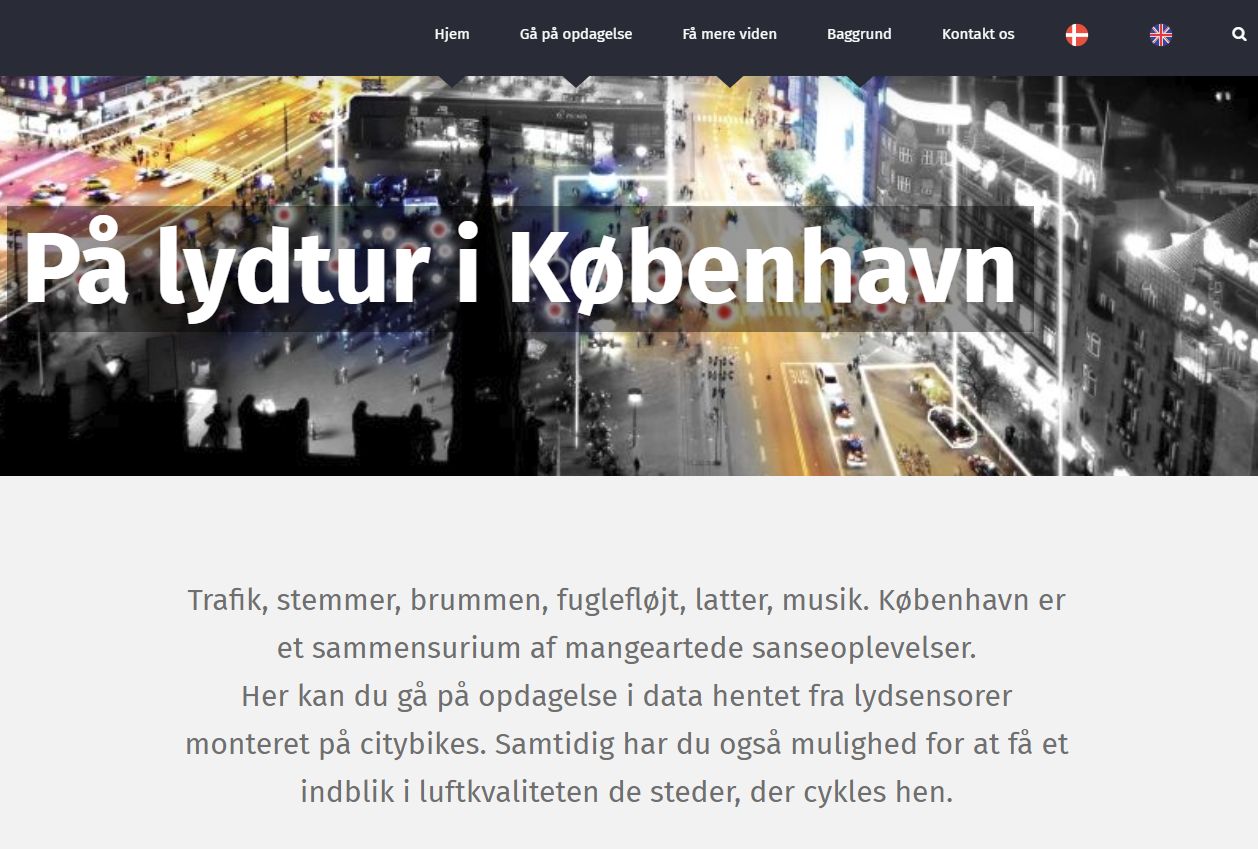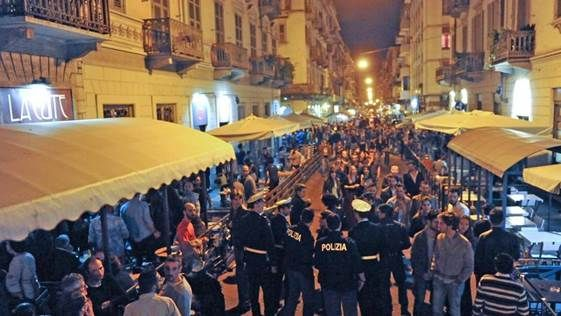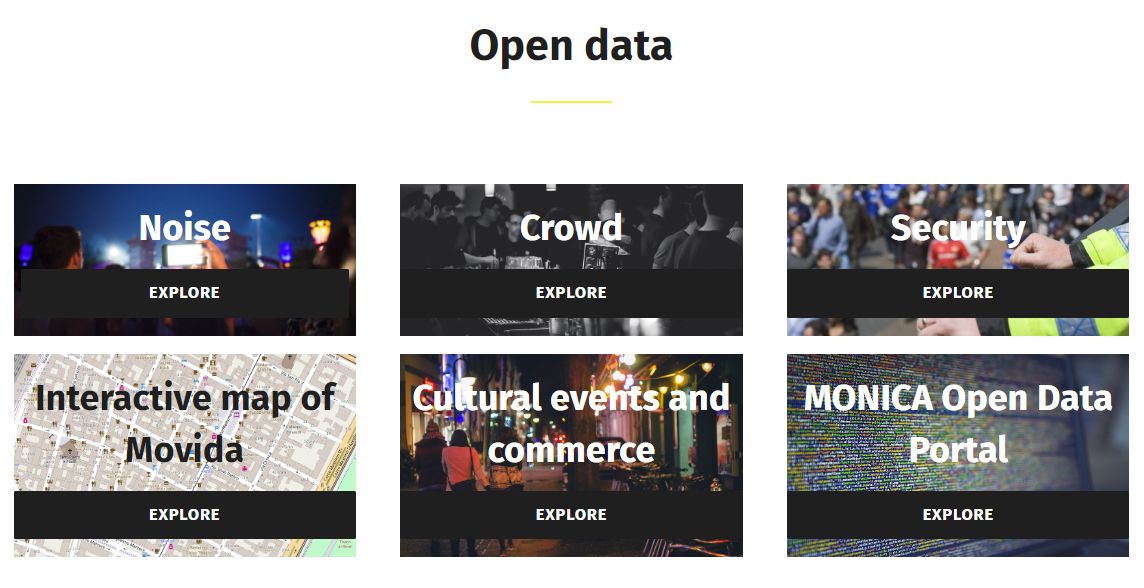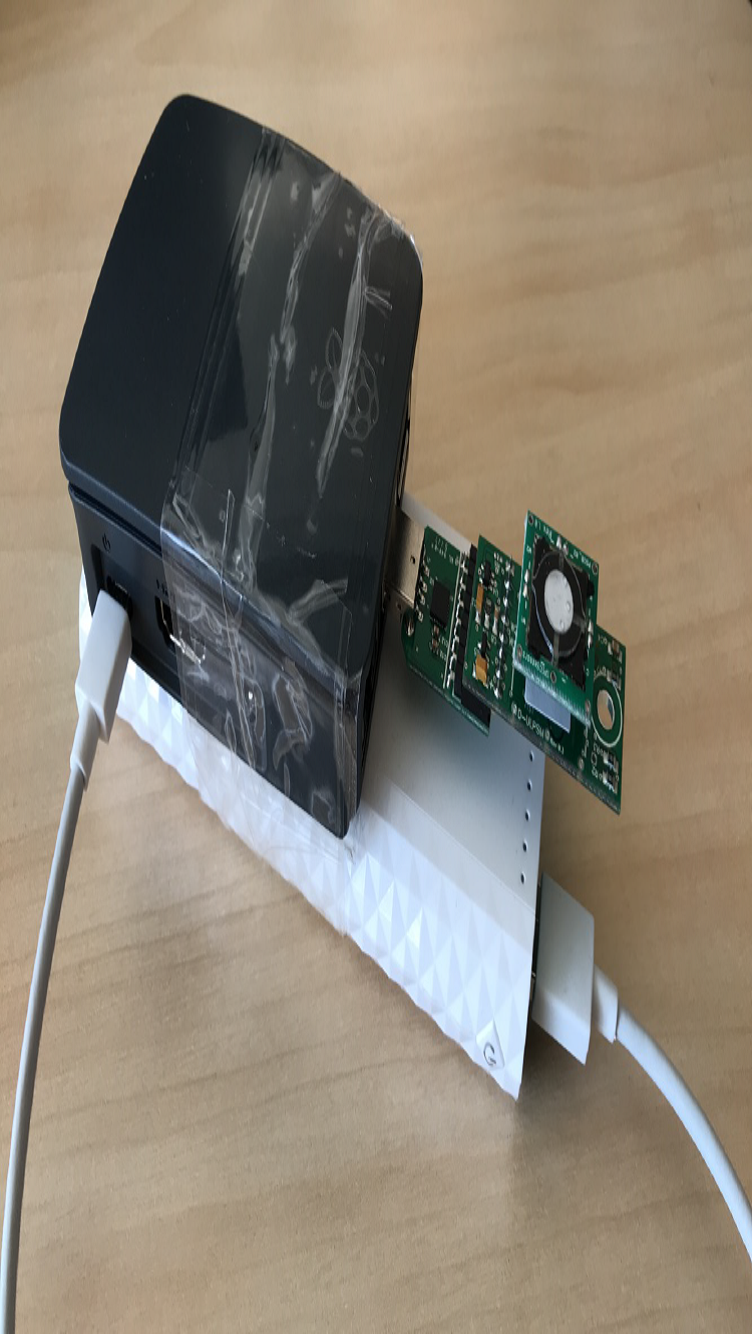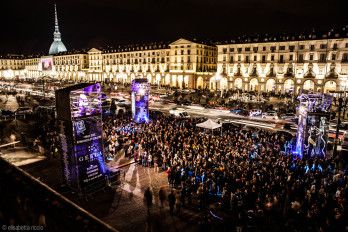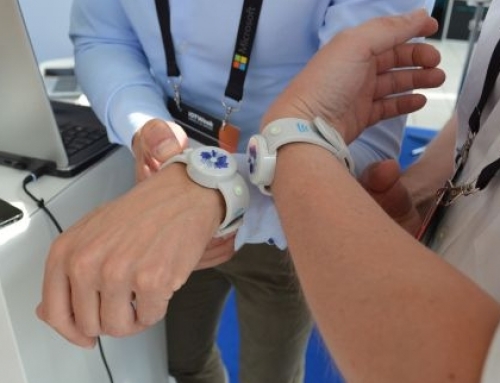Collective Awareness Platform
A Collective Awareness Platform (CAP) is an online citizen-oriented platform that promotes collective awareness about societal challenges by gathering and displaying all related data and information for the citizens. The challenge for the cities is to find solutions that can bridge the gap between cultural attractiveness and community nuisance when organising events in the inner city next to residential areas. The starting point is creating common awareness of the challenges based on facts and on this background, engage the stakeholders in identifying and developing sustainable solutions.
To this end, MONICA has established a citizen engagement platform at the city level that provides factual information about sound and/or security in the city based on various MONICA sensor data. This knowledge is then used to stimulate a collaborative co-creativity process engaging citizens and other stakeholders.

Overview
| Application areas | Type of locations | Main features |
|---|---|---|
|
|
|
Challenges, Features and Benefits
In current years, cities’ population have been growing, increasing pressure on urban services and infrastructure. Although the city is growing fast, people still expect a city that is a good place to live, and not least fun, clean, sustainable and climate-friendly. This means that the municipalities need to develop new solutions that can optimise and enhance the operation of the city in order to improve the quality of life of the citizens.
Moreover, for many years, public administrations have faced the issue of citizen participation and involvement in addressing public problems as an experience of democracy and the formation of civic virtues. Nowadays the cities can implement a bottom-up approach that opens the way to democracy through direct and binding mechanisms, thus bringing citizens closer to the decisions taken by city administration and allowing them to choose and indicate the priorities on which the municipality must intervene. The objective is to provide citizens with Open Government and e-Participation tools through which people can actively participate in the decision-making processes, have greater transparency on administrative activity and obtain factual information related to these initiatives.
The MONICA CAP makes data meaningful by presenting them in a context that is relevant to many citizens, engaging them in the creation of value and in developing new solutions to city challenges.
The platform typically consists of two layers: an awareness layer and an engagement or co-creation layer. The former provides factual information, the latter is used to invite people to interact and/or participate. In some cases, crowd funding and donations are also part of the platform.
The awareness layer outlines a particular challenge by presenting factual information and data. Based on this, participation is encouraged either through the platform functionality or in separate forums. Awareness is created through the display of open data, made available by the city’s users and presented in a way that is understandable to a wider, general public. Based on this informed knowledge, the CAP invites or unites people in creating solutions which can help improve the situation. As such, the co-creation of value takes place in collaboration with the city’s users as collectors of data.
Two MONICA CAP, which have been launched during the project, exemplifies the features. Both of the CAP websites are available in the local language as well as in English:
The Copenhagen City CAP: The primary focus is on the impact of sound/noise, e.g., by investigating correlations between sound and noise data, but other open data areas such as air quality are also considered for more CAP functionalities. The CAP for Copenhagen City can be found here: https://copenhagen.monica-project.eu.
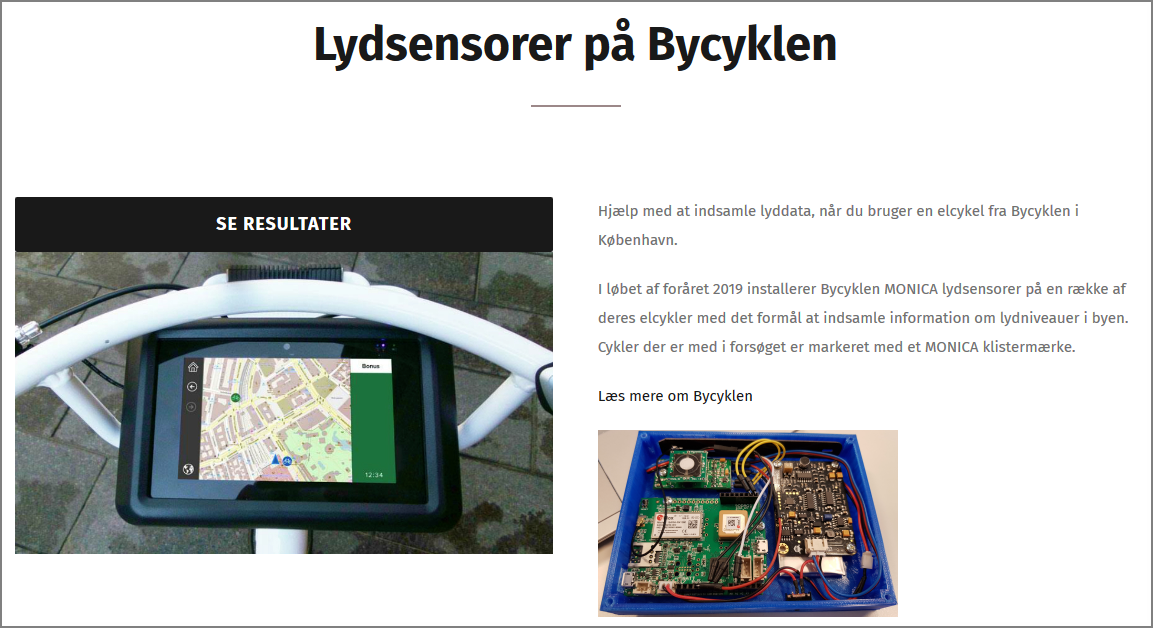
The data section of the Copenhagen CAP presents the city bicycle project
The plan is to provide comprehensive information about the environmental areas and the impact it has on citizens. Information was provided by partners in the MONICA project as well as experts from the City of Copenhagen’s Technical and Environmental Administration. An invitation to download apps or use measurement tools is also provided, motivating the user to act.
The Torino City CAP: is focused on the impact of nightlife in urban spaces. It presents factual information and data to the citizens thus strongly supporting the user engagement strategies and co-creation phase. The purpose is to create awareness about urban night-life in Torino and its impact, and has been supporting a hackathon organised by the city. The CAP for Città di Torino can be found here: https://torino.monica-project.eu.
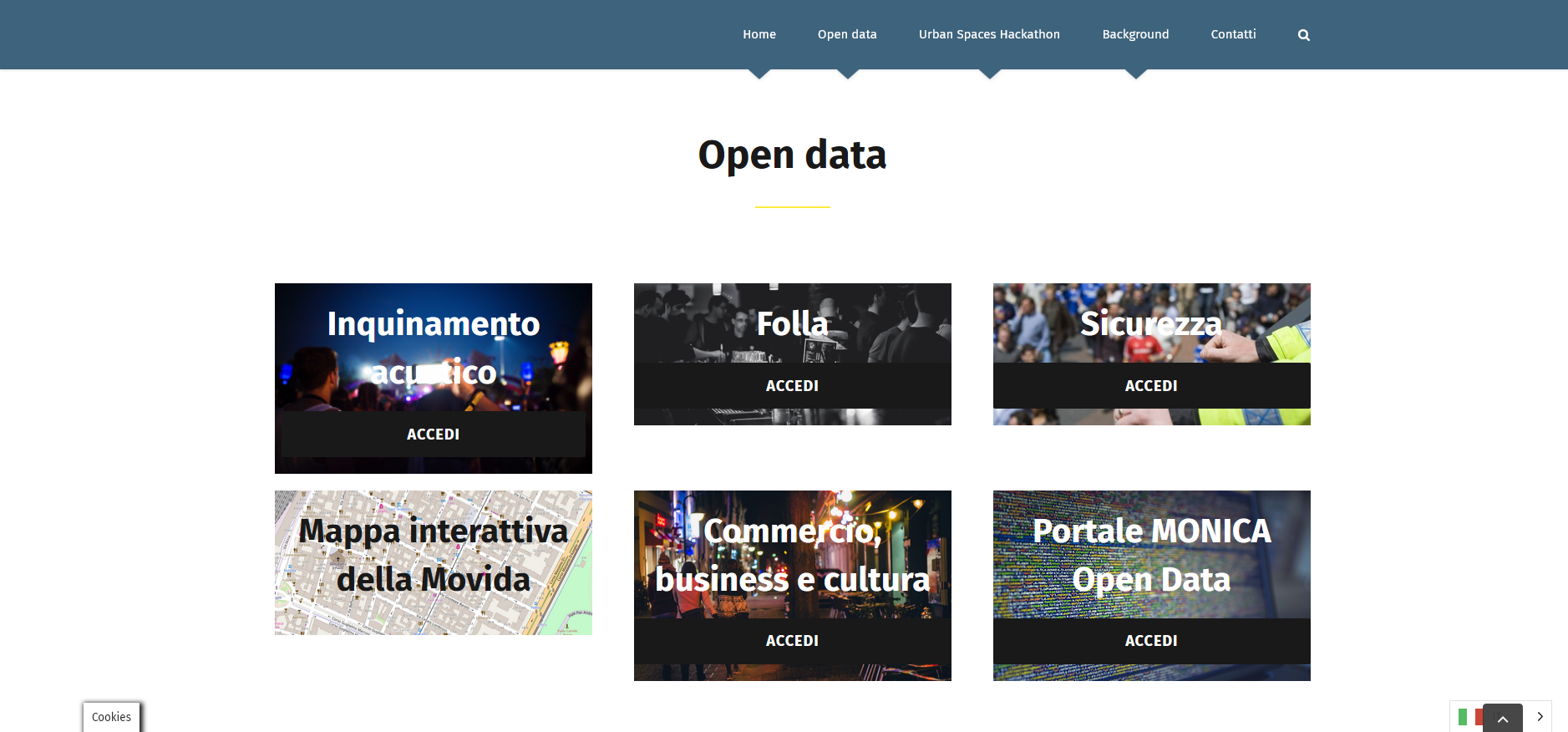
The Open data section of the CAP contains nose data, security data, general Open Data and context maps
The reader is immediately invited to explore the open data coming from the city’s own data sources and data generated by a MONICA installation. The Open Data section contains different boxes depending on the types of data: The boxes Inquinamento acustico (Noise), Folla (crowd) and Sicurezza (Security) will contain existing historical information and data from the city’s portal. Other box will be added containing already published, public information on businesses in the area and scheduled events.
To visualise data, boxes like Mappa interattiva della Movida (Interactive Map of Movida) provide interactive user interfaces to display the public data, such as sound and crowd numbers, in the form of heat maps, crowd counting numbers in real-time, etc. (Movida is the term for the night-life evolving in certain sections of the city dominated by restaurants and bars).
The benefit of the CAP is its ability to integrated Open Data from the physical environment in the city with a co-creation platform for discussion and collaboration of citizens with the city administration about sustainable solutions. The solution also represents clear benefits for the stakeholders:
- The benefits for Smart City Operators are: being able to engage citizens in co-creation activities, both for in- The benefits for Smart City Operators are that they are able to engage citizens in co-creation activities with real, factual information. This gives unique opportunities for in-project assessment purposes, but also for longer term involvement in sustainable societal solutions.
- The benefits for citizens are that they are able to benefit from online, relevant information and data and are able to take that information in to co-creation activities and to make better, informed decisions about the city’s environment, economy, infrastructure and consumption. Moreover, this makes citizens’ voice heard, and makes the city’s ICT portals more inclusive.
Technologies
The concept of the MONICA CAP is visible from the two examples, which have been launched during the project. The CAP can be integrated with any Content Management System such as WordPress, SiteCor, Joomla etc. It can also be integrated with Participatory Budgeting platform such as Consul. Both of the CAP websites are available in the local language as well as in English:
The Copenhagen City CAP
The CAP for Copenhagen City can be found here: https://copenhagen.monica-project.eu.
The Municipality of Copenhagen is looking at the environmental impact that sound and noise has on city life. In terms of citizen engagement, the Copenhagen CAP is an example of direct interaction involving citizens in the value creation by being collectors of data. Hence, the Copenhagen CAP looks at the whole city. The concept is to create awareness about environmental issues in the city in a new way, for example by mounting sensors on electric city bikes and visualise the results in the CAP.

The data section of the Copenhagen CAP presents the city bicycle project
Noise Open Data: Flexible but accurate noise monitoring have been achieved with different noise measuring devices (Sound Level Meters). Some of these are supplied as part of the MONICA Crowd and Density monitoring solution; some are available as secondary solutions. Data can be used in various ways including the MONICA Common Operational Picture (COP), which is part of the MONICA Crowd Management and Communication solution. Other types of sound level meters can be integrated with the CAP and displayed directly on the customers own websites.
In the Copenhagen CAP, sound level data have been collected from three IoT enabled Sound Level Meters. Data were collected across a defined geographical area and the CAP simultaneously displayed location, and data streams from the locations of the sound level meters. More information is found here: MONICA Sound Level Monitoring.
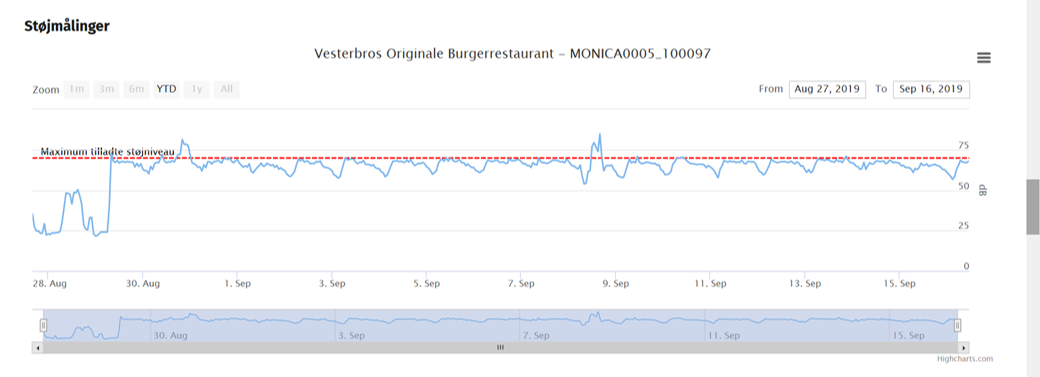
Example of a sound level sensor mounted during a street festival
The CAP can also use dynamically captured noised data from electric bicycles that are crisscrossing the city area. In the Copenhagen CAP, a mobile sensor gateway was used to dynamically make measurements in real time on the streets of Copenhagen. The data-capturing device consists of a small mobile sensor with gateway that can be mounted on a bicycle or other powered vehicle such as an electric car. The gateway consists of a Raspberry PI processor board equipped with a noise capture sensor. The gateway is flexible and open, so different types of sensors can be attached such as sound sensors or air quality sensors for NO2 and atmospheric particulate matters such as PM2.5, PM10
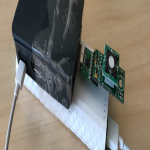
Prototype bicycle sensor
The gateway is equipped with a GPS/Galileo receiver to simultaneously obtain the location of the measurements. The gateway continuously transmits the measurements to the MONICA Cloud for storage, processing and analysis. The raw data consists of longitudinal measurements of noise following the bicycles trajectory across the city. The COP can map the measurements into geographical areas so that a noise heatmap can be generated from all the bicycles that traversed the defined area.
General Open Data: The Copenhagen CAP also provides access to Open Data sources provided by the City of Copenhagen (https://data.kk.dk, https://kbhkort.kk.dk, and http://miljoegis.mim.dk) for noise and air quality. The main idea is to complement the existing Open Data sources, which are based on measurements made in a few places in the city, with dynamically generated mass-data from sensors mounted on bicycles and other moving vehicles.
The Torino City CAP
The Cittá di Torino administration is focused on the impact of nightlife in urban spaces. The CAP concept is aimed to create awareness about urban nightlife and its impact. The city already operates a number of citizen engagement platforms for collecting proposals from citizens and for participatory budgeting. The MONICA CAP can easily be integrated with such applications. The CAP for Città di Torino can be found here: https://torino.monica-project.eu.
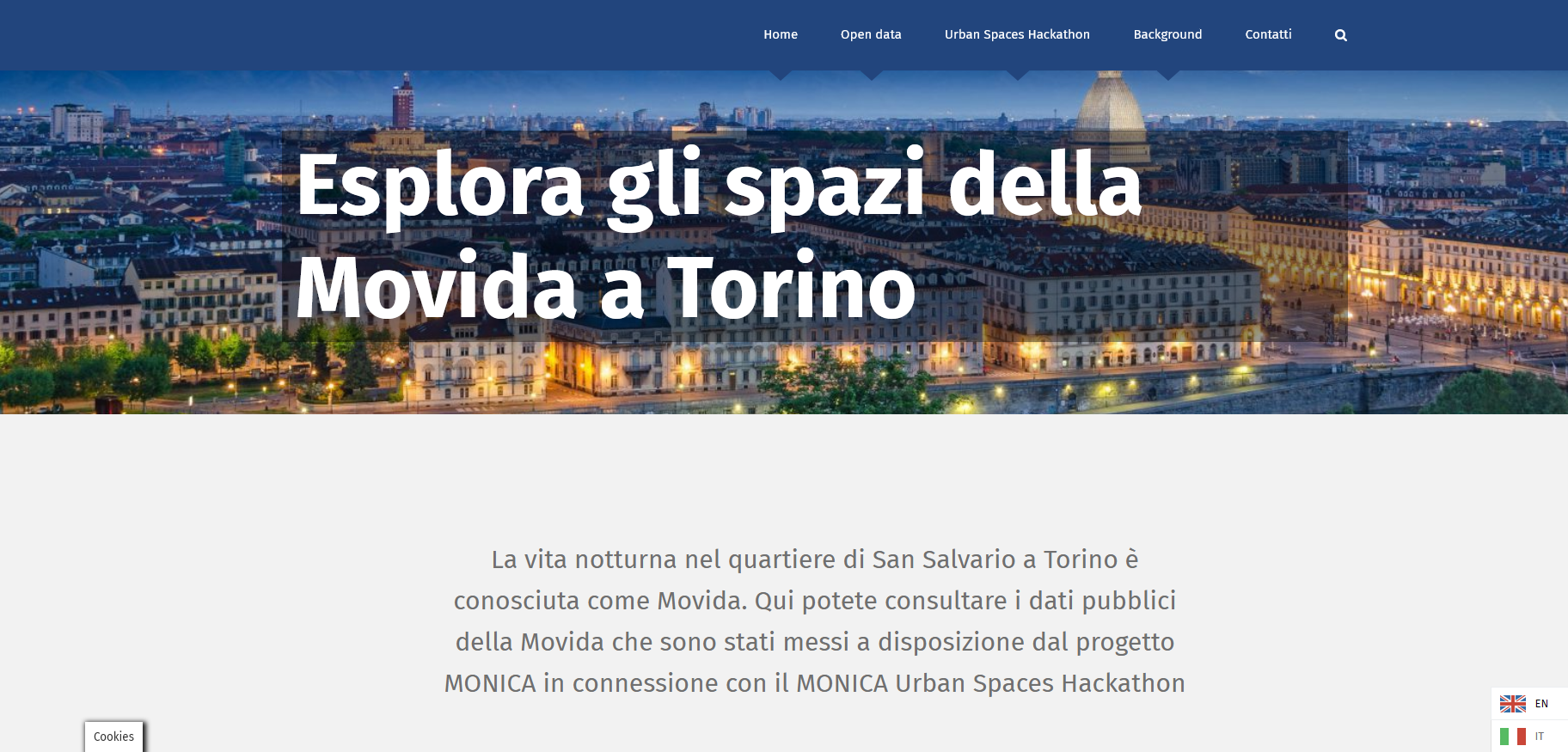
The introductory section of the Torino City CAP
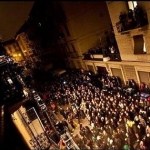
Noise measurements in the San Salvario district
Noise Open Data: The Torino CAP collects real-time or near real-time data on sound from sound measuring sensors. MONICA IoT Enabled Sound Level Meters have been permanently mounted in the San Salvario district of Torino for measuring sound levels (noise). In the future, the Contribution Analysis algorithms may be deployed to distinguish between the sound from music and the noise from the crowd. The data can then be displayed in heat maps.
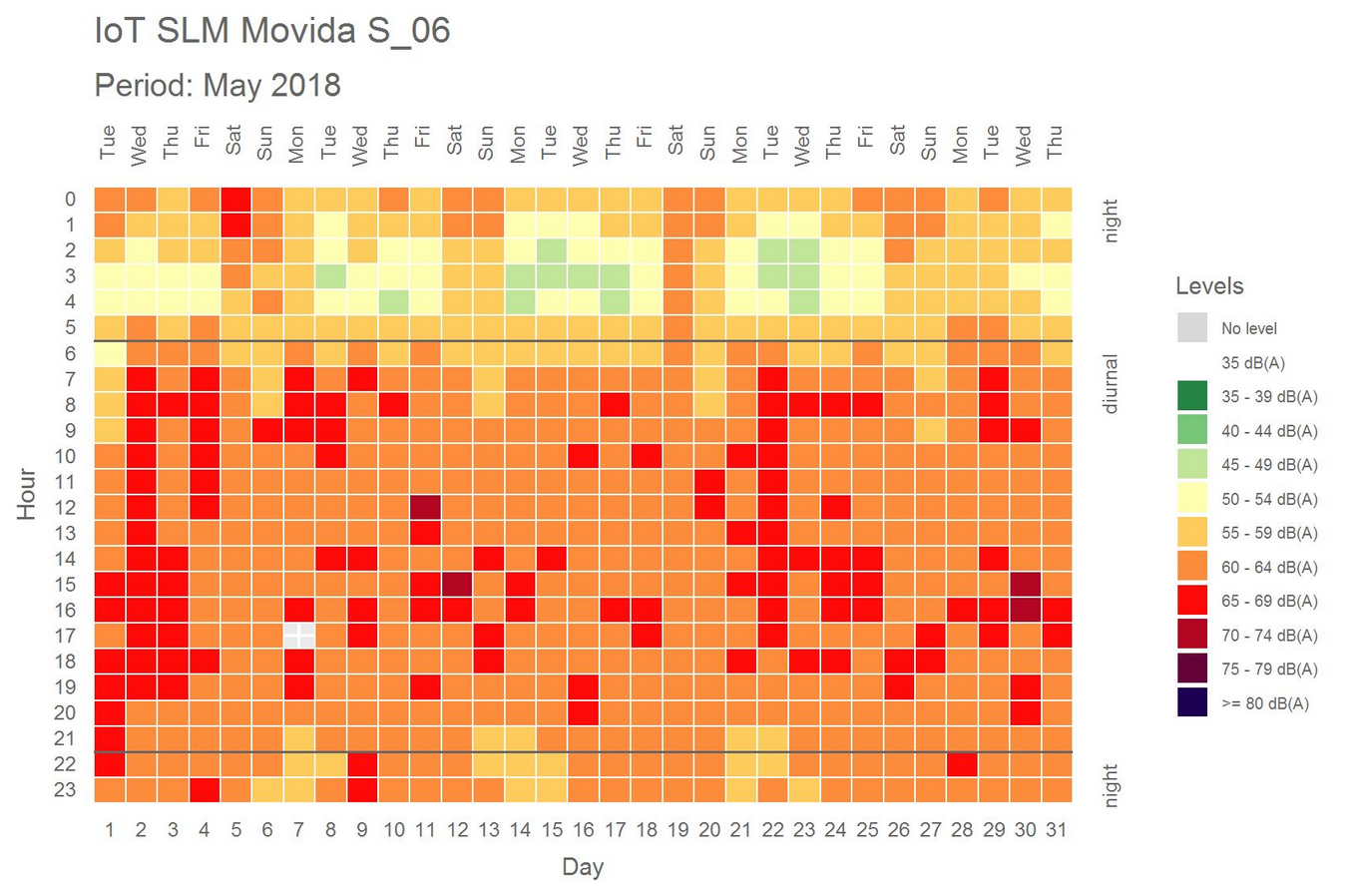
Noise monitoring from the San Salvario restaurant district for May 2018
The collected data have been organised according to date and hour and displayed in terms of noise levels in dB(A) average over one hour. The user can select the month from which to display data. In the dataset from May it is clear that sound levels are high (>60dB) every Saturday and Sunday nights between 00:00 and 02:00. Some nights (5-6 May and 19 May 2018) the noise continues until the early morning.
Crowd Monitoring: The Torino CAP has been set up to display real-time or near real-time data on crowd numbers coming from cameras in the San Salvario district of Torino. This work has not been completed at the time of writing. Please contact the contact point for more information.
Interactive Data Display: The collected data will, in the future, be organised in city maps with noise and crowd density maps.
The MONICA Collective Awareness Platform itself does not rely on separate communication networks. The CAP is cloud based and retrieves data through the city’s Open Data platform.
For sensor communication, please refer to the MONICA Crowd and Density Monitoring solution.
Associated MONICA solutions
The MONICA Collective Awareness Platform is related to and have been demonstrated together with these additional MONICA solutions:
- MONICA Crowd and Capacity Monitoring
- MONICA Sound Level Monitoring
- MONICA Crowd Management and Communication (the COP)
- City Noise Maps using Electrical Bikes Sensors
- Sound Composition Analysis
Implementation
The MONICA Collective Awareness Platform can be implemented as a customer specific solution independent of other MONICA solutions.
Preparation
No special technical preparation is necessary for the MONICA Collective Awareness Platform.
Deployment
The solution can be deployed freely to any locations.
Operation
The MONICA Collective Awareness Platform can be operated by the city’s own ICT department or as a Platform as a Service (PaaS) or fully operated by a third-party vendor.
Reproducibility means that a MONICA solution (including data sets, software code, etc) can be made available to others for reproducing the same results.
No reproducibility data sets are available for the MONICA Collective Awareness Platform solution.
Technical regulations
There are no specific technical regulations related to the MONICA Collective Awareness Platform
Other local/national regulations
The data and information collected at the MONICA Collective Awareness Platform from user interaction may be of personal nature.
Ethics
With regard to the collection and processing of personal data, the GDPR allows Member States to enact national provisions on certain issues as stipulated by the National Data Protection Authority. For example, Member States will have discretion to enact national provisions imposing further requirements regarding the appointment of Data Protection Officers.
- Internal procedures must be developed to protect personal data
- Internal procedures to protect the rights of data subjects must be implemented
- The CAP owner is identified as the “Data Controller”
- The CAP operator is identified as a “Data processor”
- A Data Processor Agreement must be drafted and signed by these two parties
- Data Processor Agreements with third parties must be in place if relevant.
- A Data Protection Officer can be designated by the Data Controller
- A Data Management Plan is required which established the intended processing of personal data and the purpose of such processing
- A Data Protection Impact Assessment must be carried out based on the Data Management Plan and
No lessons learned has been collected for this solution.
Replication
Business Models
The Business Model Canvas is used to give a high-level overview of the contents in the value configuration and in the customer group side related to a specific value proposition. This tool is used to map out all details of the MONICA business models based on the value proposition, target groups, the partner constellations, and revenue models outlined below.
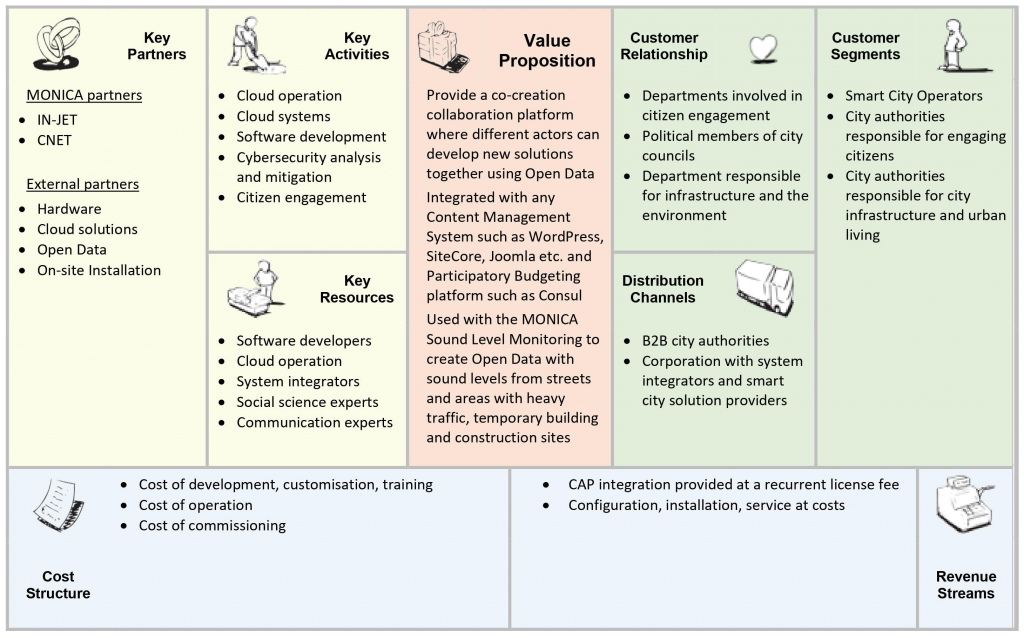
Business Model Canvas for the MONICA Collective Awareness Platform solution © In-JeT ApS
Revenue models
The choice of business model and pricing schemes is entirely up to the partner that have commercialised the solutions. Hence, the following information is solely provided as a guide to the expected business conditions that the solutions might be provided at. Please contact the responsible partner for further, up-to-date details.
| Component | Type | Anticipated revenue model |
|---|---|---|
| CAP Platform | Cloud service | Can be provided to the city’s own ICT department as consultancy costs. Or as a Platform as a Service (PaaS) or fully operated by a third-party vendor against recurrent service charges |
| Sound Level Meters | Hardware | Can be provided at initial costs for hardware and design, configuration costs for installation |
Reference deployments in MONICA
During the project period 2017 – 2020, the MONICA Collective Awareness Platform was deployed and tested in real-life situations in two cities.
| MONICA demonstration events | |
|---|---|
| City of Copenhagen |
 Copenhagen Townhall |
| Città di Torino |
 Torino |
For more information, please see the contact list below
Replicators
No replication demonstrations were undertaken.
The following partner is responsible for various components of the MONICA Collective Awareness Platform solution:
| Solution | Responsible | Acronym | Details |
|---|---|---|---|
| CAP Platform | In-JeT ApS | IN-JET | IN-JET will provide the CAP, data repository and other websites for the CAP. |
| Sound Level Meters | In-JeT ApS | IN-JET | IN-JET will provide Sound Level Meters for noise measurements. |
| Bicycle Noise Sensors | CNet Svenska AB | CNET | CNET will provide the noise and environmental sensors for mounting on electric bicycles and cars. |
